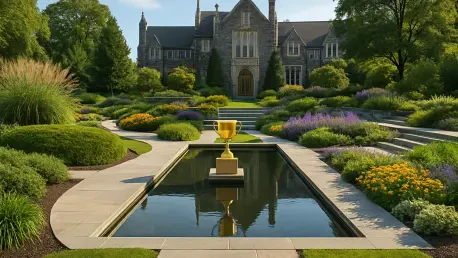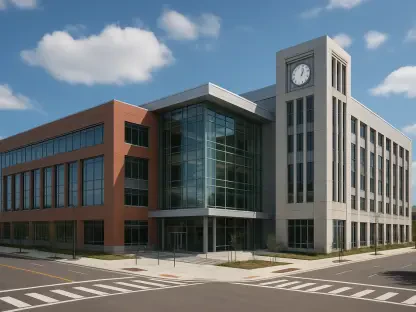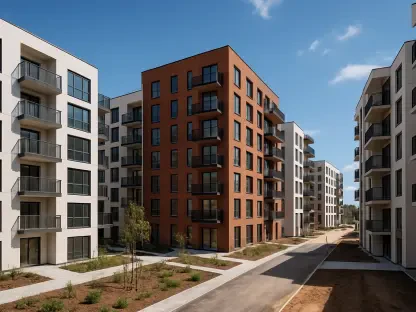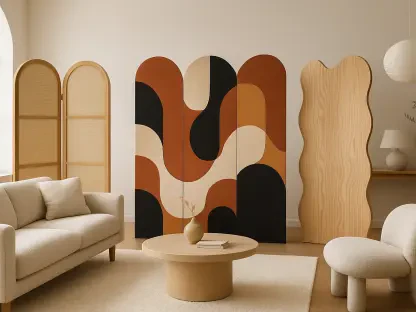In a field where the past often collides with the pressing demands of the present, Mark Hough, Duke University’s esteemed Landscape Architect, has carved out a legacy that masterfully bridges this divide, earning him the prestigious Alfred B. LaGasse Medal from the American Society of Landscape Architects (ASLA). This award, the highest honor for contributions to the management and conservation of natural resources and public landscapes, was celebrated at the ASLA annual conference in New Orleans on October 11, recognizing Hough’s transformative impact on Duke’s campus since he joined the university over two decades ago. Guided by the 2000 Campus Master Plan to maintain a “historic and dynamic campus,” Hough’s work reflects a profound respect for Duke’s early 20th-century Gothic charm while adapting its spaces for modern academic life. His approach not only enhances the aesthetic and functional value of the campus but also sets a benchmark in landscape architecture, blending history, sustainability, and community engagement into a cohesive vision that resonates far beyond university grounds.
Preserving Heritage at East Campus Quad
Hough’s dedication to historical preservation shines through in the revitalization of East Campus Quad, a project that exemplifies his commitment to maintaining Duke’s storied legacy. By meticulously researching original plans from the 1920s, crafted by renowned firms like Horace Trumbauer and the Olmsted Brothers, he ensured that every design decision honored the campus’s foundational aesthetic. The quad, once disrupted by vehicular traffic, has been transformed into a pedestrian-friendly sanctuary through limited access and thoughtful additions like new tree plantings and layered landscapes. This ongoing, multi-year restoration focuses on enhancing the space’s intimacy, making it a more inviting area for students and faculty alike. The result is a seamless blend of past and present, where historical integrity remains intact while the quad evolves to meet today’s needs for quiet reflection and casual gatherings, proving that heritage can coexist with contemporary functionality.
Beyond the aesthetic and historical considerations, the East Campus Quad project underscores Hough’s strategic approach to long-term campus planning. This initiative is not merely about restoration but about reimagining how such spaces can serve a modern university community while retaining their original character. The careful selection of plantings and design elements ensures durability and low maintenance, addressing practical concerns without compromising on beauty. Additionally, the project reflects a broader vision of accessibility, creating pathways that encourage foot traffic and foster a sense of connection across the campus. By prioritizing pedestrian experience over vehicular convenience, Hough has redefined the quad as a central, unifying space that echoes Duke’s early design principles while adapting to the rhythms of current academic life. This balance of reverence and innovation makes the quad a standout example of how historical spaces can remain relevant in an ever-changing environment.
Transforming Spaces at Bryan Center Plaza
Another testament to Hough’s ability to adapt Duke’s campus for modern use is the transformation of Bryan Center Plaza into a vibrant hub of student activity. What was once an uninspiring cement walkway has been reimagined as a dynamic space with shaded seating areas and adjacent quiet zones like Crown Commons, catering to the diverse needs of students, faculty, and staff. This incremental project, evolving over a decade from 2006 to 2016 with key additions like Penn Pavilion and the Brodhead Center, reflects a deliberate, thoughtful approach to placemaking. The plaza now serves as a central meeting point, facilitating everything from casual conversations to organized events, and has become integral to campus life. Hough’s vision here demonstrates an acute understanding of how spatial design can influence social interaction, turning a previously mundane area into a cornerstone of community engagement at Duke.
The impact of Bryan Center Plaza extends beyond its physical transformation, highlighting Hough’s foresight in addressing the evolving dynamics of university spaces. By integrating elements that encourage both lively gatherings and moments of solitude, the plaza accommodates a wide range of activities, from studying under shaded canopies to hosting cultural events that bring the campus together. This adaptability ensures that the space remains relevant as student needs shift over time, embodying the “dynamic” aspect of Duke’s guiding Campus Master Plan. Furthermore, the project showcases how incremental changes, when guided by a cohesive vision, can yield profound results, creating an environment that feels both intentional and organic. Hough’s work at the plaza illustrates the power of landscape architecture to shape not just physical spaces but also the social fabric of an academic institution, fostering connections that enrich the university experience.
Pioneering Sustainability with Duke Pond
Hough’s innovative spirit is perhaps most evident in the creation of Duke Pond, a project born out of necessity during the 2007 drought crisis and completed in 2015 as a 5.5-acre stormwater collection site. This initiative saves Duke approximately 100 million gallons of municipal water annually by supplying the campus cooling system, addressing a critical environmental challenge with practical ingenuity. Yet, the pond is far more than a utilitarian solution; it doubles as a scenic retreat that enhances campus beauty and supports local biodiversity, attracting wildlife and visitors alike. From students seeking a peaceful escape to engineers studying sustainable design, the pond draws a diverse crowd, reflecting Hough’s ability to create spaces that serve multiple purposes. This project stands as a powerful example of how landscape architecture can tackle pressing ecological issues while enriching the aesthetic and communal value of a university campus.
The significance of Duke Pond lies not only in its environmental contributions but also in its role as a symbol of forward-thinking design within academic settings. By integrating water conservation with natural beauty, Hough has crafted a space that educates as much as it conserves, offering tangible lessons in sustainability for the Duke community. The pond’s design encourages interaction with the environment, providing walking paths and viewing areas that invite contemplation and appreciation of nature’s resilience. Its success highlights a growing recognition in landscape architecture that sustainable solutions must also inspire and engage their users, ensuring long-term impact. Hough’s work here demonstrates that even the most functional projects can carry profound cultural and emotional weight, transforming a response to crisis into a beloved campus landmark that aligns with Duke’s broader mission of innovation and stewardship.
Reflecting Broader Trends in Landscape Design
Hough’s projects collectively mirror a significant trend in landscape architecture toward multifunctional spaces that balance historical reverence with contemporary demands. His meticulous attention to Duke’s early 20th-century Gothic designs ensures that renovations enhance rather than erase the campus’s legacy, a challenge many professionals face amid rapid urbanization and environmental shifts. At the same time, his focus on functionality—whether through pedestrian-friendly quads, vibrant social hubs, or sustainable water systems—addresses the immediate needs of a modern university population. This dual commitment reflects a broader movement in the field to create landscapes that serve aesthetic, social, and ecological purposes simultaneously. Hough’s ability to navigate these complex demands positions his work as a compelling case study for how cultural heritage can be preserved while embracing progress and innovation in design.
Moreover, the recognition of Hough’s contributions through the Alfred B. LaGasse Medal underscores the growing importance of landscape architecture in shaping community identity and environmental responsibility. His approach at Duke highlights a consensus within the profession that public spaces must do more than look appealing; they must foster connection, support sustainability, and adapt to future challenges. Each of Hough’s projects, from the historically grounded East Campus Quad to the ecologically focused Duke Pond, exemplifies this ethos, offering insights into how landscapes can function as vital components of institutional missions. This alignment with industry trends suggests that Hough’s influence extends beyond Duke, providing a framework for other universities and public entities to rethink their own spaces in ways that honor tradition while preparing for what lies ahead in campus development.
Building Community Through Thoughtful Spaces
A defining feature of Hough’s designs is their capacity to strengthen community ties within Duke’s academic environment, aligning seamlessly with the university’s mission as a hub of learning and interaction. The pedestrian focus of East Campus Quad creates a serene backdrop for reflection and dialogue, while the bustling energy of Bryan Center Plaza offers a stage for vibrant student life through events and casual meetups. Similarly, Duke Pond provides a tranquil escape that invites personal connection to nature, enriching the campus experience for all. These spaces are not merely decorative; they are purposeful environments that encourage social bonds, relaxation, and intellectual exchange. Hough’s work reveals an understanding that landscapes play a critical role in shaping how individuals interact with their surroundings, making them indispensable to the fabric of university life.
The community-building aspect of Hough’s designs also speaks to a deeper intent to create lasting emotional resonance within Duke’s spaces. By tailoring each project to serve specific social functions—whether it’s a quiet corner for study or a central plaza for celebration—Hough ensures that the campus remains a place of belonging for diverse groups. This focus on human experience elevates his work beyond technical achievement, emphasizing the role of landscape architecture in nurturing a sense of place. The varied atmospheres of his projects cater to different moods and needs, from the contemplative to the communal, demonstrating a nuanced grasp of how physical environments influence behavior and connection. As such, Hough’s contributions at Duke stand as a reminder that well-designed spaces can profoundly impact the quality of life and learning within an academic setting, fostering unity and purpose.
Leading the Way for Future Innovations
Looking back, Mark Hough’s receipt of the Alfred B. LaGasse Medal marked a significant moment of acknowledgment for his transformative efforts at Duke University, where he redefined campus landscapes with a rare blend of historical sensitivity and modern ingenuity. His projects, spanning key areas like East Campus Quad, Bryan Center Plaza, and Duke Pond, showcased a commitment to sustainability, functionality, and community that resonated on a national scale. Moving forward, his work offers a clear path for other institutions to follow, suggesting that landscape architects can play a pivotal role in addressing complex challenges through integrated design solutions. Future projects at universities and public spaces might draw inspiration from Hough’s ability to anticipate evolving needs while safeguarding heritage, ensuring landscapes remain relevant and impactful. As the field continues to evolve, Hough’s legacy provides a foundation for exploring how spaces can adapt to environmental and social shifts, encouraging ongoing dialogue and innovation in the discipline.









